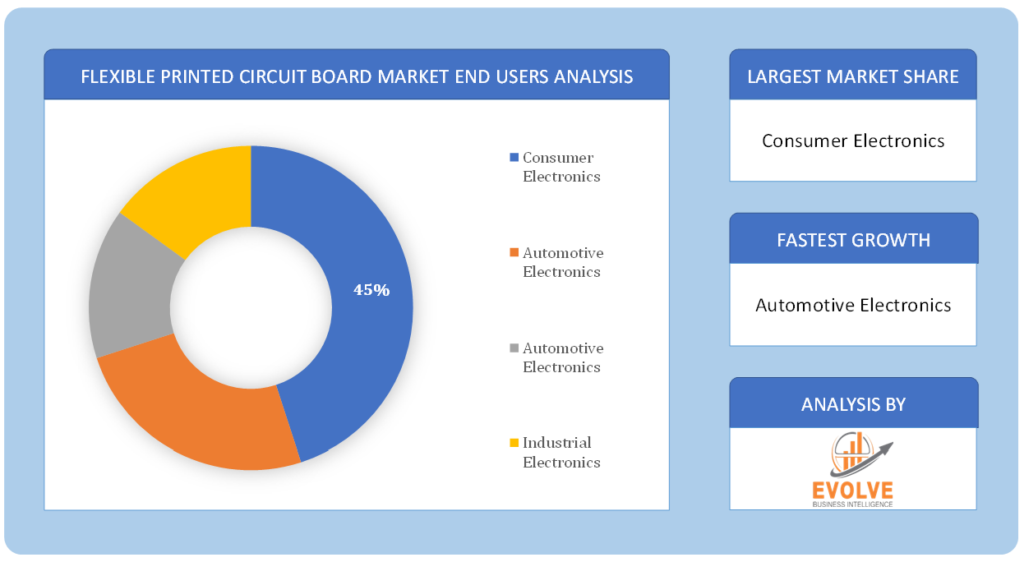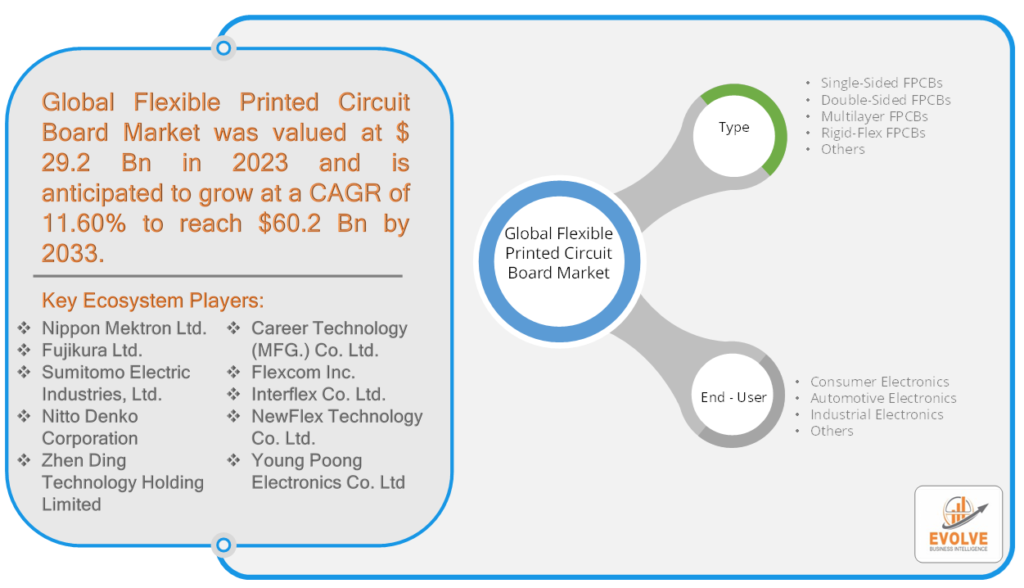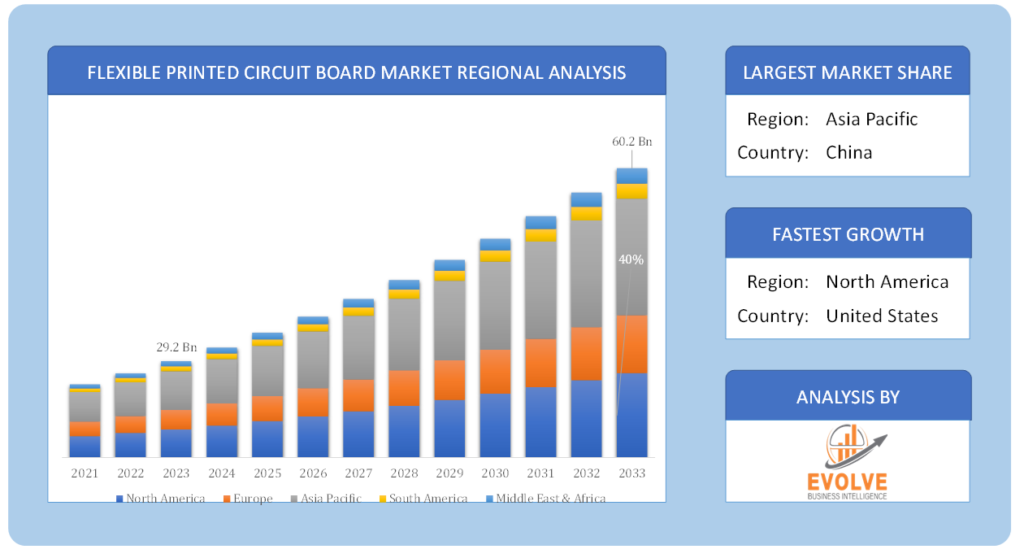Flexible Printed Circuit Board Market Overview
The global Flexible Printed Circuit Board Market Size is expected to reach USD 60.2 Bilion by 2033. The global Flexible Printed Circuit Board industry size accounted for USD 29.2 Bilion in 2023 and is expected to expand at a compound annual growth rate (CAGR) of 11.60% from 2023 to 2033. Flexible Printed Circuit Boards (FPCBs) are an integral part of modern electronic devices, revolutionizing the way circuits are designed and manufactured. FPCBs are highly flexible and can be bent, twisted, or folded to fit into compact spaces, making them ideal for applications where traditional rigid circuit boards are impractical. These boards consist of a thin, flexible substrate made of polyimide or similar materials, with conductive traces printed or etched onto the surface. FPCBs find extensive use in various industries such as consumer electronics, automotive electronics, and industrial electronics.
Global Flexible Printed Circuit Board Market Synopsis
The COVID-19 pandemic has had a significant impact on the global economy, including the Flexible Printed Circuit Board market. With lockdowns and restrictions on manufacturing and supply chain disruptions, the market witnessed a decline in demand during the initial phase of the pandemic. However, as the world adapts to the new normal, the market is gradually recovering and is expected to witness a steady growth rate in the post-COVID scenario. The increased reliance on remote working and the surge in demand for electronic devices have acted as catalysts for the market’s recovery.
Flexible Printed Circuit Board Market Dynamics
The major factors that have impacted the growth of Flexible Printed Circuit Board are as follows:
Drivers:
Growing Demand for Flexible and Wearable Electronics
One of the key driving factors for the Flexible Printed Circuit Board market is the growing demand for flexible and wearable electronics. The rise of smart devices, such as smartwatches, fitness trackers, and flexible displays, has fueled the need for flexible circuit boards. These devices require lightweight and bendable components that can conform to the shape of the product. FPCBs enable the seamless integration of electronics into curved surfaces, enhancing the overall design aesthetics and functionality of wearable devices.
Restraint:
- High Initial Investment and Complex Manufacturing Process
While the Flexible Printed Circuit Board market holds immense potential, it faces certain restraining factors. One such factor is the high initial investment and complex manufacturing process involved in producing FPCBs. The specialized equipment and materials required for manufacturing flexible circuit boards increase the overall production cost. Moreover, the intricate nature of the manufacturing process requires skilled labor and expertise, further adding to the expenses. These factors pose a challenge for new entrants and small-scale manufacturers, hindering the market’s growth to some extent.
Opportunity:
Advancements in Internet of Things (IoT) Technology
An opportunity factor that presents itself for the Flexible Printed Circuit Board market is the advancements in Internet of Things (IoT) technology. The proliferation of IoT devices in various sectors, including healthcare, automotive, and industrial automation, opens up new avenues for FPCBs. These devices rely on seamless connectivity and miniaturized components, which can be achieved through the utilization of flexible circuit boards. The increasing adoption of IoT technology and the demand for smart, interconnected devices create a significant growth opportunity for the market.
Flexible Printed Circuit Board Segment Overview
By Type
Based on the Type, the market is segmented based on Single-Sided FPCBs, Double-Sided FPCBs, Multilayer FPCBs, Rigid-Flex FPCBs, and Others. the Multilayer FPCBs hold the largest share in the market. Multilayer FPCBs offer enhanced functionality and high-density interconnections, making them suitable for complex electronic applications. The ability to integrate multiple circuit layers within a single board makes multilayer FPCBs the preferred choice for advanced electronic devices.
By End-user
 Based on End-user, the market has been divided into Consumer Electronics, Automotive Electronics, Industrial Electronicsand Others. the Consumer Electronics segment holds the largest share. The increasing demand for smartphones, tablets, wearable devices, and home appliances drive the growth of FPCBs in the consumer electronics.
Based on End-user, the market has been divided into Consumer Electronics, Automotive Electronics, Industrial Electronicsand Others. the Consumer Electronics segment holds the largest share. The increasing demand for smartphones, tablets, wearable devices, and home appliances drive the growth of FPCBs in the consumer electronics.
Global Flexible Printed Circuit Board Market Regional Analysis
Based on region, the global Flexible Printed Circuit Boardmarket has been divided into North America, Europe, Asia-Pacific, South America and Middle East & Africa. Asia pacific is projected to dominate the use of the market followed by the Europe and North America.
 Asia Pacific Market
Asia Pacific Market
Asia-Pacific is a dominant region in the Flexible Printed Circuit Board market. The presence of major manufacturing hubs, such as China, Japan, South Korea, and Taiwan, contributes to the region’s market dominance. These countries are renowned for their expertise in electronics manufacturing and are home to several prominent FPCB manufacturers. The rapid growth of consumer electronics and automotive industries in the region further fuels the demand for FPCBs. Additionally, favorable government initiatives, such as subsidies and tax benefits, promote the growth of the electronics industry, thereby driving the market for FPCBs in Asia-Pacific.
North America Market
North America is another significant region in the Flexible Printed Circuit Board market. The region’s robust research and development activities, coupled with technological advancements, propel the adoption of FPCBs in various industries. The presence of major technology giants and a thriving start-up ecosystem contribute to the demand for FPCBs in North America. The region witnesses high demand for flexible circuit boards in the automotive sector, particularly for applications related to electric vehicles (EVs) and autonomous driving systems. Moreover, the increasing deployment of IoT devices and smart home solutions creates opportunities for the market’s growth in North America.
Competitive Landscape
The global Flexible Printed Circuit Board market is highly competitive, with numerous players offering a wide range of software solutions. The competitive landscape is characterized by the presence of established companies, as well as emerging startups and niche players. To increase their market position and attract a wide consumer base, the businesses are employing various strategies, such as product launches, and strategic alliances.
Prominent Players:
- Nippon Mektron Ltd.
- Fujikura Ltd.
- Sumitomo Electric Industries, Ltd.
- Nitto Denko Corporation
- Zhen Ding Technology Holding Limited
- Career Technology (MFG.) Co. Ltd.
- Flexcom Inc.
- Interflex Co. Ltd.
- NewFlex Technology Co. Ltd.
- Young Poong Electronics Co. Ltd.
Key Development:
April 2023: Fujikura Ltd., announced a significant development. The company introduced a new generation of flexible circuit boards that utilize advanced materials and manufacturing techniques. These FPCBs offer improved flexibility, durability, and electrical performance, making them ideal for demanding applications in the automotive and aerospace industries. Fujikura’s latest product launch demonstrates its commitment to technological innovation and addressing evolving market needs.
Scope of the Report
Global Flexible Printed Circuit Board Market, by Type
- Single-Sided FPCBs
- Double-Sided FPCBs
- Multilayer FPCBs
- Rigid-Flex FPCBs
- Others
Global Flexible Printed Circuit Board Market, by End-user
- Consumer Electronics
- Automotive Electronics
- Automotive Electronics
- Industrial Electronics
- Others
Global Flexible Printed Circuit Board Market, by Region
- North America
- US
- Canada
- Mexico
- Europe
- UK
- Germany
- France
- Italy
- Spain
- Benelux
- Nordic
- Rest of Europe
- Asia Pacific
- China
- Japan
- South Korea
- Indonesia
- Austalia
- Malaysia
- India
- Rest of Asia Pacific
- South America
- Brazil
- Argentina
- Rest of SouthAmerica
- Middle East &Africa
- Saudi Arabia
- UAE
- Egypt
- SouthAfrica
- Rest of Middle East & Africa
| Parameters | Indicators |
|---|---|
| Market Size | 2033: $29.2 Bilion |
| CAGR | 11.60% CAGR (2023-2033) |
| Base year | 2022 |
| Forecast Period | 2023-2033 |
| Historical Data | 2021 |
| Report Coverage | Revenue Forecast, Competitive Landscape, Growth Factors, and Trends |
| Key Segmentations | Product, End Use |
| Geographies Covered | North America, Europe, Asia-Pacific, Latin America, Middle East, Africa |
| Key Vendors | Nippon Mektron Ltd., Fujikura Ltd., Sumitomo Electric Industries, Ltd., Nitto Denko Corporation, Zhen Ding Technology Holding Limited, Career Technology (MFG.) Co. Ltd., Flexcom Inc., Interflex Co. Ltd., NewFlex Technology Co. Ltd., and Young Poong Electronics Co. Ltd |
| Key Market Opportunities | Advancements in Internet of Things (IoT) Technology |
| Key Market Drivers | Growing Demand for Flexible and Wearable Electronics |
REPORT CONTENT BRIEF:
- High-level analysis of the current and future Flexible Printed Circuit Board market trends and opportunities
- Detailed analysis of current market drivers, restraining factors, and opportunities in the future
- Flexible Printed Circuit Board market historical market size for the year 2021, and forecast from 2023 to 2033
- Flexible Printed Circuit Board market share analysis at each product level
- Competitor analysis with a detailed insight into its product segment, Automotive Electronics strength, and strategies adopted.
- Identifies key strategies adopted including product launches and developments, mergers and acquisitions, joint ventures, collaborations, and partnerships as well as funding taken and investment done, among others.
- To identify and understand the various factors involved in the global Flexible Printed Circuit Board market affected by the pandemic
- To provide a detailed insight into the major companies operating in the market. The profiling will include the Automotive Electronics health of the company’s past 2-3 years with segmental and regional revenue breakup, product offering, recent developments, SWOT analysis, and key strategies.









